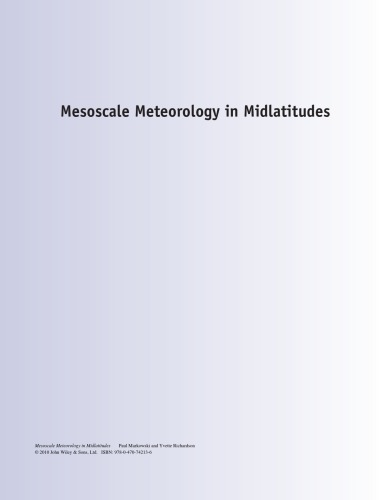

Most ebook files are in PDF format, so you can easily read them using various software such as Foxit Reader or directly on the Google Chrome browser.
Some ebook files are released by publishers in other formats such as .awz, .mobi, .epub, .fb2, etc. You may need to install specific software to read these formats on mobile/PC, such as Calibre.
Please read the tutorial at this link. https://ebooknice.com/page/post?id=faq
We offer FREE conversion to the popular formats you request; however, this may take some time. Therefore, right after payment, please email us, and we will try to provide the service as quickly as possible.
For some exceptional file formats or broken links (if any), please refrain from opening any disputes. Instead, email us first, and we will try to assist within a maximum of 6 hours.
EbookNice Team

Status:
Available0.0
0 reviews
ISBN 10: 0470742135
ISBN 13: 9780470742136
Author: Paul M Markowski, Yvette P Richardson
Mesoscale Meteorology in Mid-Latitudes presents the dynamics of mesoscale meteorological phenomena in a highly accessible, student-friendly manner. The book's clear mathematical treatments are complemented by high-quality photographs and illustrations. Comprehensive coverage of subjects including boundary layer mesoscale phenomena, orographic phenomena and deep convection is brought together with the latest developments in the field to provide an invaluable resource for mesoscale meteorology students.
Mesoscale Meteorology in Mid-Latitudes functions as a comprehensive, easy-to-use undergraduate textbook while also providing a useful reference for graduate students, research scientists and weather industry professionals.
Illustrated in full colour throughout
Covers the latest developments and research in the field
Comprehensive coverage of deep convection and its initiation
Uses real life examples of phenomena taken from broad geographical areas to demonstrate the practical aspects of the science
PART I General Principles
1 What is the Mesoscale?
1.1 Space and time scales
1.2 Dynamical distinctions between the mesoscale and synoptic scale
2 Basic Equations and Tools
2.1 Thermodynamics
2.2 Mass conservation
2.3 Momentum equations
2.4 Vorticity and circulation
2.5 Pressure perturbations
2.6 Thermodynamic diagrams
2.7 Hodographs
3 Mesoscale Instabilities
3.1 Static instability
3.2 Centrifugal instability
3.3 Inertial instability
3.4 Symmetric instability
3.5 Shear instability
PART II Lower Tropospheric Mesoscale Phenomena
4 The Boundary Layer
4.1 The nature of turbulent fluxes
4.2 Surface energy budget
4.3 Structure and evolution of the boundary layer
4.4 Boundary layer convection
4.5 Lake-effect convection
4.6 Urban boundary layers
4.7 The nocturnal low-level wind maximum
5 Air Mass Boundaries
5.1 Synoptic fronts
5.2 Drylines
5.3 Outflow boundaries
5.4 Mesoscale boundaries originating from differential surface heating
6 Mesoscale Gravity Waves
6.1 Basic wave conventions
6.2 Internal gravity wave dynamics
6.3 Wave reflection
6.4 Critical levels
6.5 Structure and environments of ducted mesoscale gravity waves
6.6 Bores
PART III Deep Moist Convection
7 Convection Initiation
7.1 Requisites for convection initiation and the role of larger scales
7.2 Mesoscale complexities of convection initiation
7.3 Moisture convergence
7.4 Elevated convection
8 Organization of Isolated Convection
8.1 Role of vertical wind shear
8.2 Single-cell convection
8.3 Multicellular convection
8.4 Supercellular convection
9 Mesoscale Convective Systems
9.1 General characteristics
9.2 Squall line structure
9.3 Squall line maintenance
9.4 Rear inflow and bow echoes
9.5 Mesoscale convective complexes
10 Hazards Associated with Deep Moist Convection
10.1 Tornadoes
10.2 Nontornadic, damaging straight-line winds
10.3 Hailstorms
10.4 Flash floods
PART IV Orographic Mesoscale Phenomena
11 Thermally Forced Winds in Mountainous Terrain
11.1 Slope winds
11.2 Valley winds
12 Mountain Waves and Downslope Windstorms
12.1 Internal gravity waves forced by two-dimensional terrain
12.2 Gravity waves forced by isolated peaks
12.3 Downslope windstorms
12.4 Rotors
13 Blocking of the Wind by Terrain
13.1 Factors that govern whether air flows over or around a terrain obstacle
13.2 Orographically trapped cold-air surges
13.3 Lee vortices
mesoscale meteorology in midlatitudes
mesoscale meteorology in midlatitudes amazon
mesoscale meteorology textbook
mesoscale meteorology book
mesoscale meteorology and forecasting
mesoscale meteorology
Tags: Paul M Markowski, Yvette P Richardson, Mesoscale, Meteorology